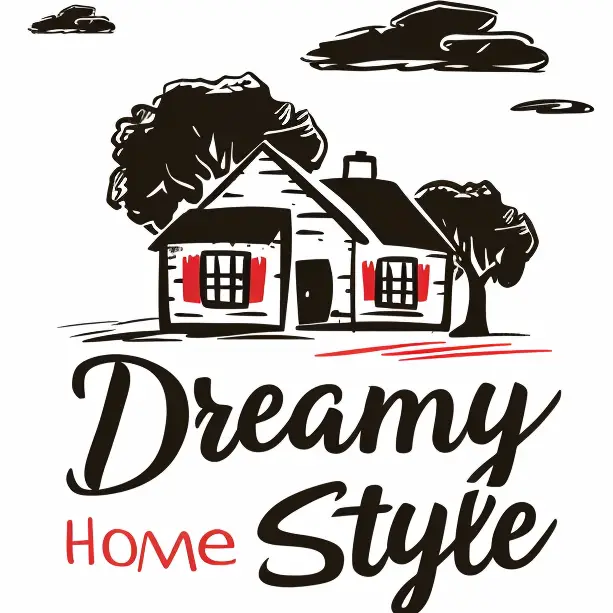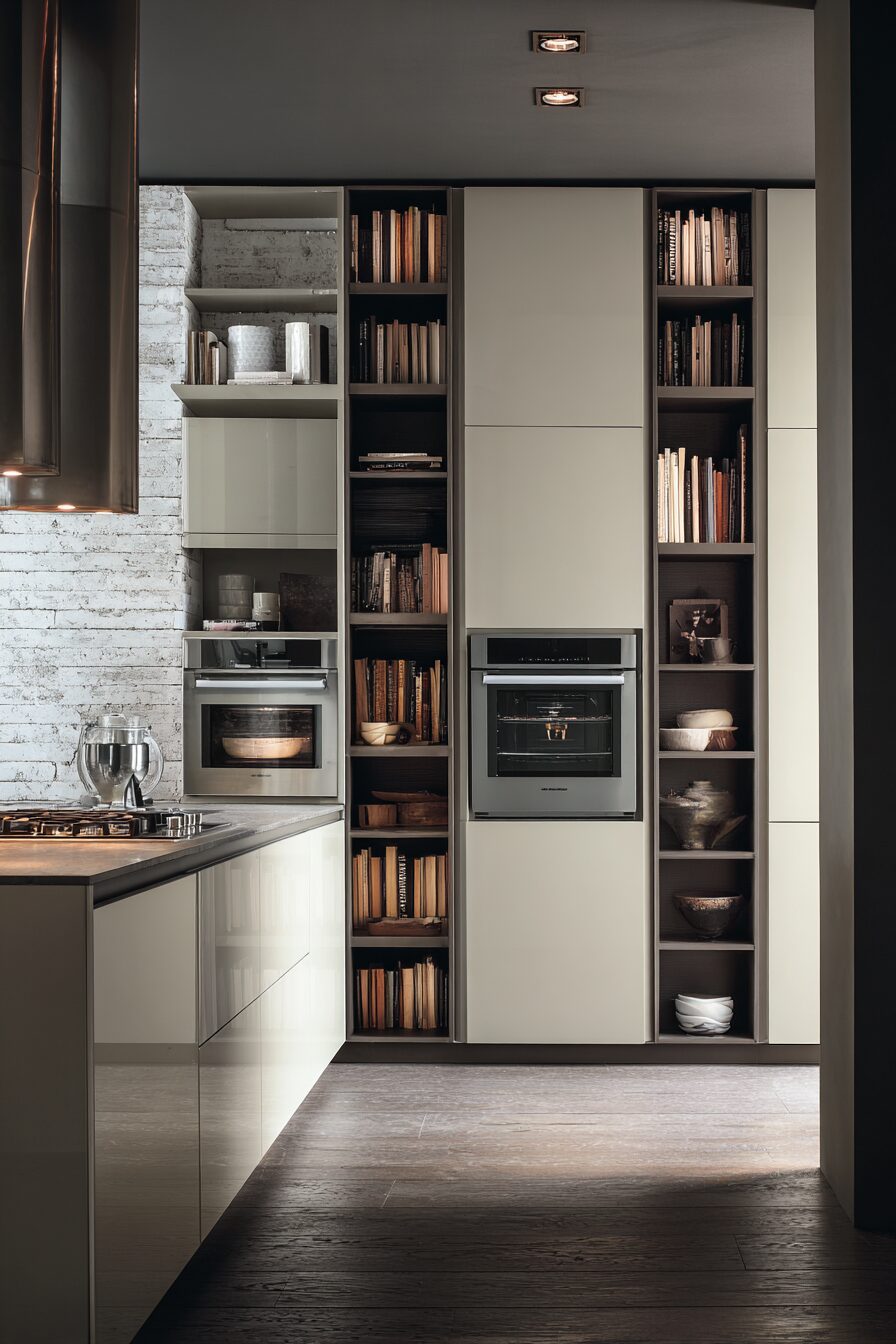Taupe kitchen cabinets offer that perfect middle ground between bold and boring, bringing warmth and sophistication to your kitchen without overwhelming the space.
This versatile neutral—a beautiful blend of gray and brown—creates a backdrop that works with virtually any style, from ultra-modern to cozy farmhouse.
Ready to discover how this underrated color choice can transform your kitchen into something extraordinary?
Two-Tone Taupe Design: The Perfect Partnership
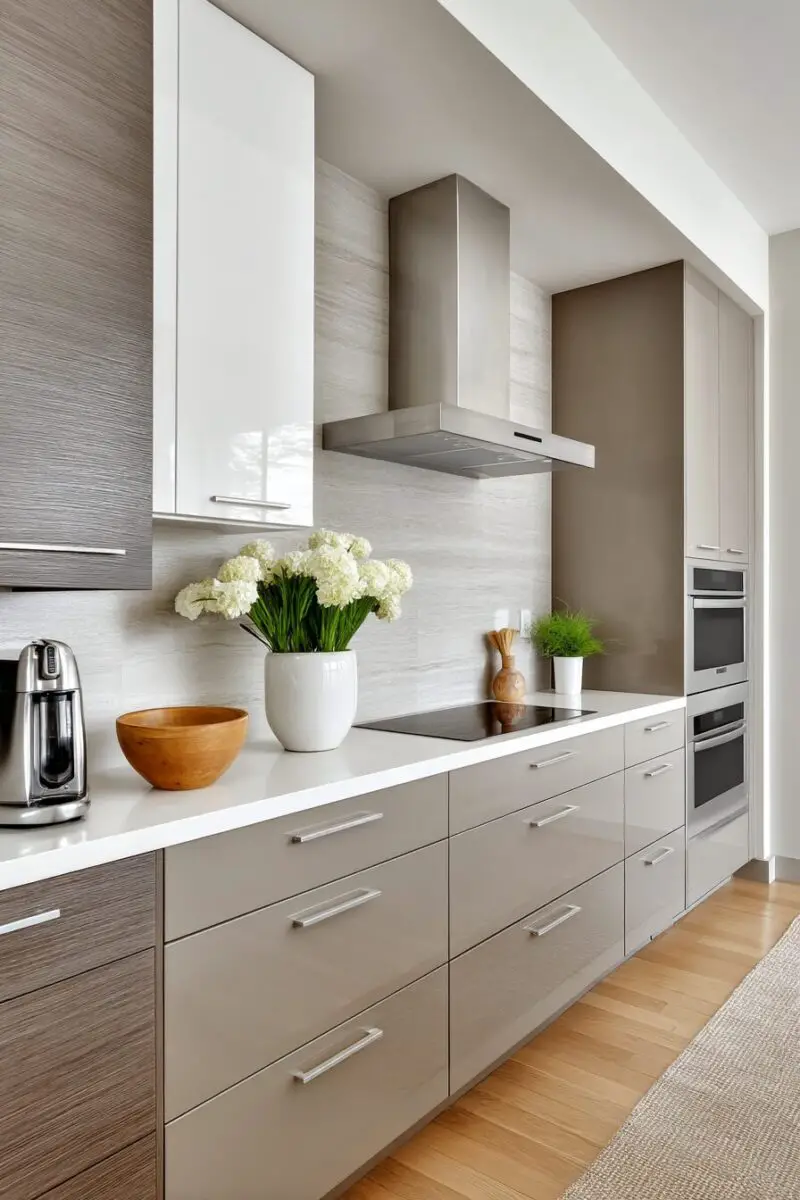
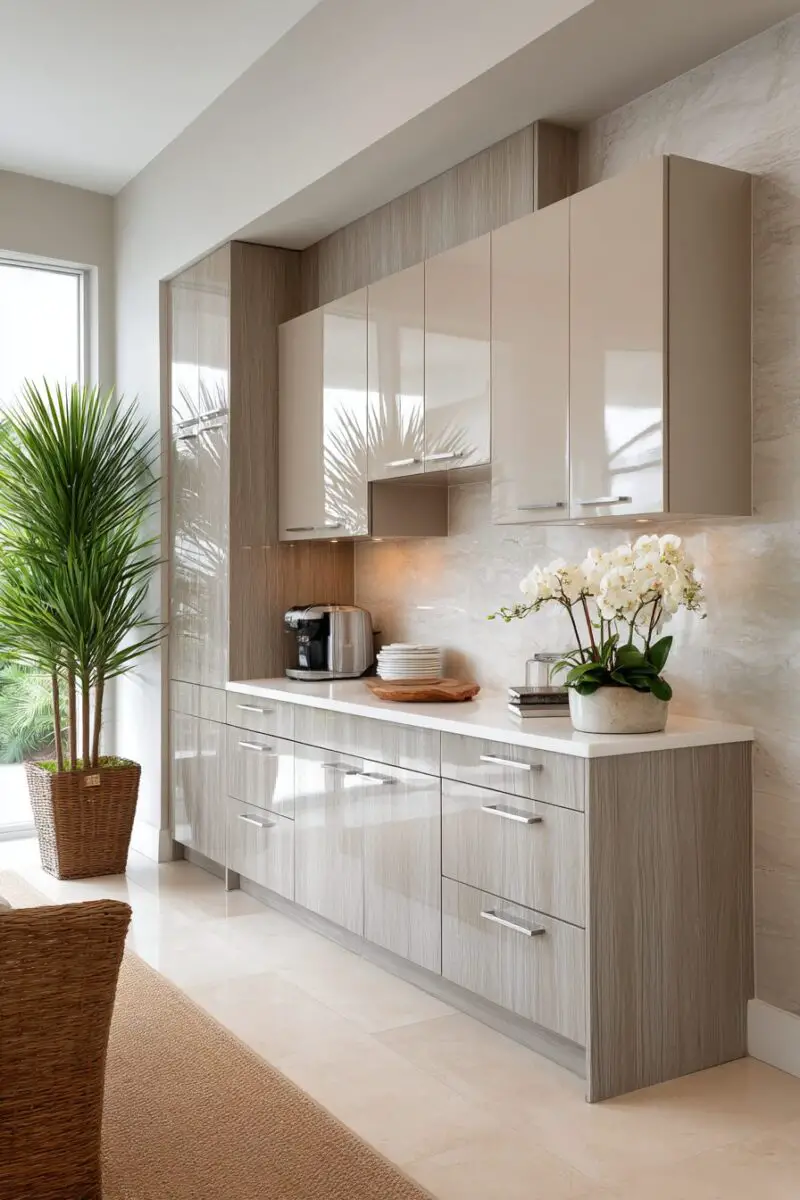
Two-tone kitchen designs have exploded in popularity, and taupe cabinets create the ideal base for this trending style.
The magic happens when you pair upper taupe cabinets with a darker base, creating visual interest while maintaining a cohesive look.
Alternatively, imagine taupe base cabinets grounding your space while crisp white uppers keep things light and airy overhead.
This combination works brilliantly because taupe naturally complements virtually any color without competing for attention.
For a truly dramatic effect, consider pairing taupe with deep navy or forest green on an island or pantry section.
The contrast creates an instant focal point while the taupe elements ensure the bold color doesn’t overwhelm your space.
Designers particularly love combining taupe with black for a contemporary look that still feels warm and inviting.
When executing a two-tone design, maintaining consistency in cabinet style and hardware unifies the different colors.
The beauty of this approach lies in its versatility—different color combinations can lean traditional, modern, or transitional depending on your preferences.
Real estate agents confirm that well-executed two-tone kitchens with neutral foundations like taupe can increase home value significantly.
For a subtle two-tone effect, consider varying the taupe shades themselves—perhaps slightly darker on bottom cabinets and lighter above.
The key to success with this approach is ensuring adequate contrast between your chosen colors without creating a jarring visual disconnect.
Professional designers recommend looking at both colors in your actual kitchen lighting before committing, as taupe can read differently depending on light conditions.
When selecting complementary colors, consider the undertones in your specific taupe shade—some lean more gray, while others have stronger brown influences.
Budget-conscious remodelers appreciate that this trend allows for phased renovations, perhaps painting uppers now and tackling lowers later.
Two-tone designs also create natural organization zones in your kitchen, with different cabinet colors subtly defining cooking, cleaning, and prep areas.
Homeowners particularly love how this approach allows incorporation of trends without committing the entire kitchen to a potentially dated look.
For maximum impact, carry your color scheme beyond just cabinets—perhaps incorporating your secondary color in backsplash tiles or window treatments.
Photography doesn’t always capture the subtle beauty of two-tone taupe kitchens, but in person, the dimension and depth created is remarkably sophisticated.
This approach works equally well in open concept spaces and smaller galley kitchens, though the specific color balance might shift based on available space.
Taupe with Bold Hardware: Jewelry for Your Kitchen
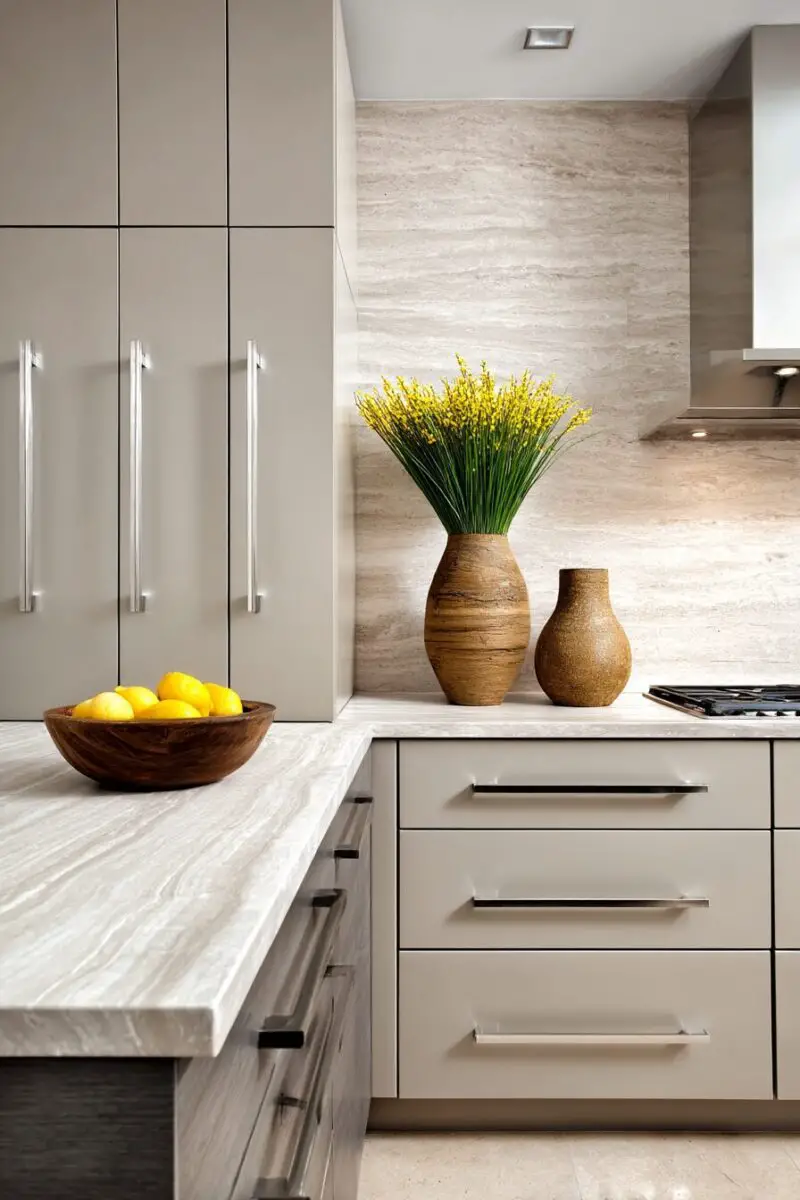
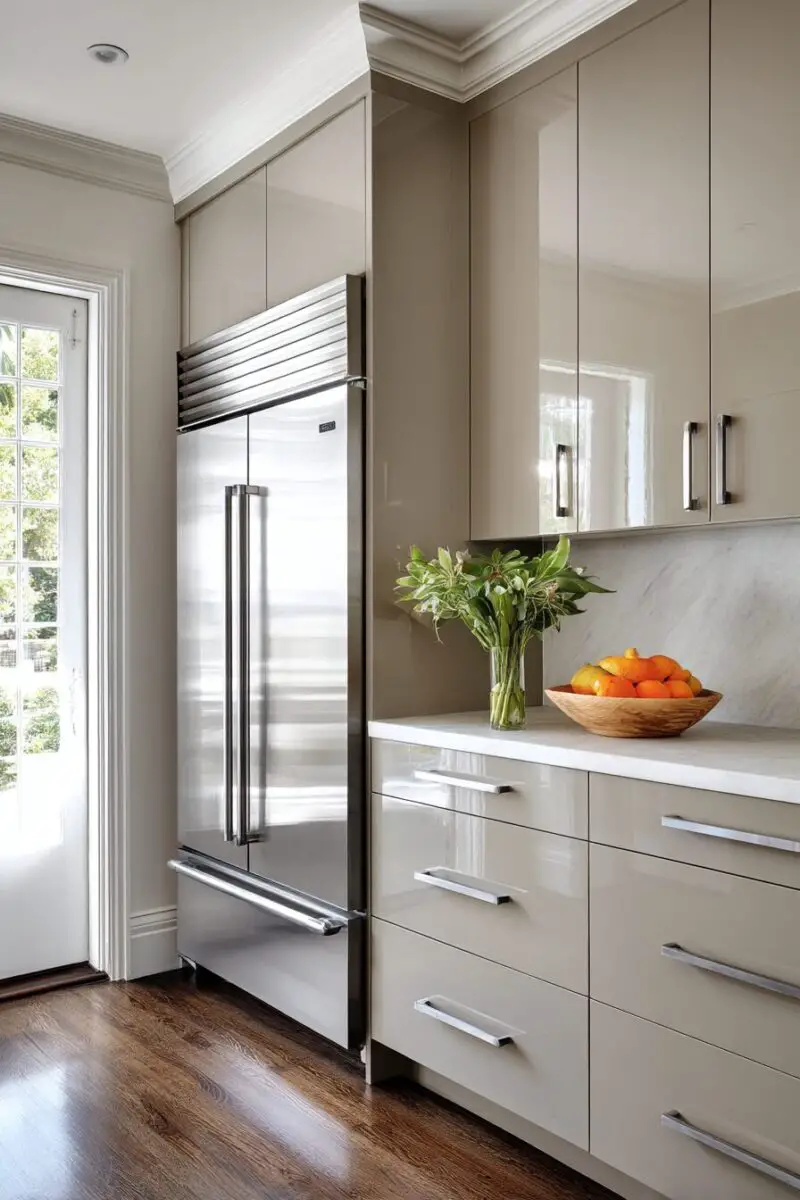
Picture your taupe cabinets as the perfect canvas awaiting that final artistic touch—distinctive hardware that transforms the entire space.
Hardware selection represents perhaps the most affordable yet impactful way to elevate taupe cabinets from pleasant to extraordinary.
Matte black pulls and knobs create dramatic contrast against taupe’s soft background, instantly modernizing even traditional cabinet styles.
Alternatively, brushed brass or gold hardware brings warmth and luxury, highlighting the subtle brown undertones often found in taupe finishes.
The hardware style itself—from sleek bar pulls to ornate cup pulls—dramatically influences whether your taupe kitchen reads as contemporary, traditional, or transitional.
Oversized handles make a bold statement while simultaneously improving functionality, especially on larger drawers or pantry cabinets.
Unique shapes like hexagonal knobs or leather-wrapped pulls give taupe cabinets unexpected personality without overwhelming their subtle charm.
Hardware experts recommend choosing pieces that feel substantial in your hand, as quality hardware provides tactile satisfaction every time you open a cabinet.
For a truly cohesive look, consider coordinating your hardware finish with your faucet and light fixtures.
Designers often recommend bringing cabinet samples to hardware showrooms, as taupe’s undertones can interact differently with various metal finishes.
The contrast between taupe’s softness and the defined lines of well-designed hardware creates visual tension that keeps the eye engaged.
Mixed metals—perhaps combining brass and black, or nickel and bronze—create sophisticated dimension when paired with the neutral foundation taupe provides.
Many homeowners overlook the transformative power of cabinet hardware, but designers consider it the equivalent of selecting the perfect accessories for an outfit.
For budget-conscious remodels, standard cabinet boxes with taupe fronts and exceptional hardware create a custom look without custom pricing.
Crystal or glass knobs paired with taupe introduce an element of unexpected elegance, particularly effective in traditional or vintage-inspired spaces.
Integrated finger pulls, which eliminate visible hardware entirely, offer a sleek minimalist approach that lets the taupe finish itself become the star.
When selecting hardware, consider not just appearance but also comfort—how the piece feels when gripped from your typical angle.
Taupe’s adaptability means you can easily update hardware years later without needing to refinish or replace the cabinets themselves.
Interior designers particularly value how taupe cabinets provide flexibility to experiment with different hardware styles as tastes and trends evolve.
The subtle character of taupe ensures that even the most distinctive hardware choices appear intentional rather than overwhelming.
Design Your Dream Room in Minutes!
🏡 Start Creating FREE →Light vs. Dark Taupe: Setting the Mood
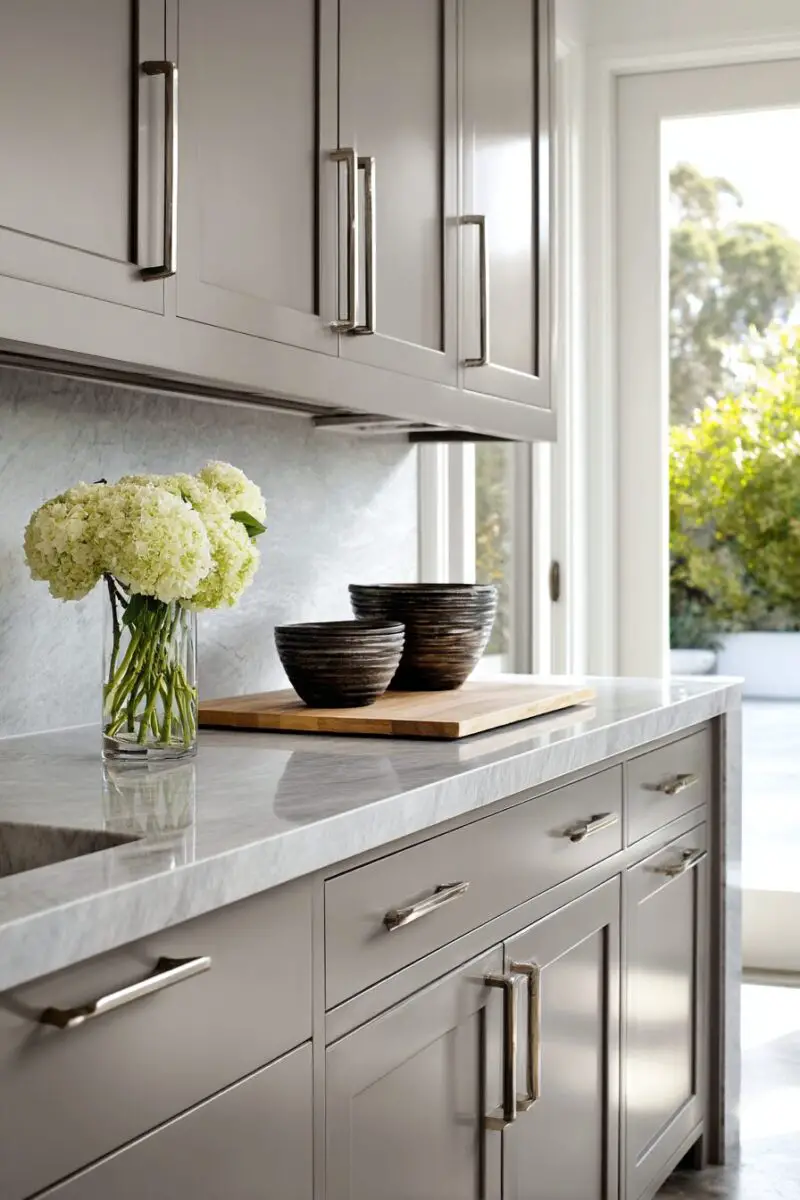
The taupe family spans a remarkable range of shades, from barely-there pale tones that whisper through a space to rich, deep versions that ground and define.
Light taupe cabinets—those with significant white and gray undertones—create airy, expansive kitchens that feel clean and contemporary.
These lighter variations particularly benefit smaller kitchens or spaces with limited natural light, visually expanding cramped quarters.
The subtle warmth of even the lightest taupe prevents the clinical feel that sometimes accompanies pure white cabinets.
Design experts note how light taupe cabinets hide dust and minor stains better than white while still maintaining that coveted bright, open feel.
At the opposite end of the spectrum, deep taupe cabinets introduce dramatic presence without the heaviness of true brown or black.
These darker interpretations create cozy, enveloping kitchens that feel both sophisticated and welcoming.
Middle-range taupe shades offer perhaps the greatest versatility, reading differently as lighting changes throughout the day.
Morning sunlight might highlight their warmer brown undertones, while evening light emphasizes the sophisticated gray elements.
When selecting your perfect taupe, always view samples vertically and under different lighting conditions to understand how they’ll appear installed.
Remember that flat cabinet fronts display color differently than detailed or recessed panel styles, where shadows create natural color variation.
Darker taupes make architectural details and cabinet hardware pop, while lighter shades create a more subtle, uniform appearance.
Flooring choices significantly impact how your taupe cabinets are perceived—lighter floors create contrast with dark taupe, while darker floors ground lighter cabinets.
Light taupe cabinets paired with white countertops create seamless transitions, while dark taupe with similar countertops makes a bolder statement.
Kitchen designers recommend choosing your taupe shade after selecting your flooring and countertops, as these larger elements should drive cabinet color decisions.
The perfect taupe often contains undertones that complement other fixed elements in your home, creating flow between spaces.
Northern-facing kitchens benefit from taupe with warmer undertones to counteract cool natural light, while southern exposures can handle cooler taupe variations.
Professional color consultants evaluate your existing fixtures, appliances, and adjacent rooms when helping select the ideal taupe shade for cohesiveness.
The psychological impact of light versus dark taupe shouldn’t be underestimated—lighter shades energize while deeper tones create calm and intimacy.
Most importantly, your taupe selection should reflect your personal preference and how you want your kitchen to feel, regardless of current trends.
Taupe with Natural Elements: Organic Harmony
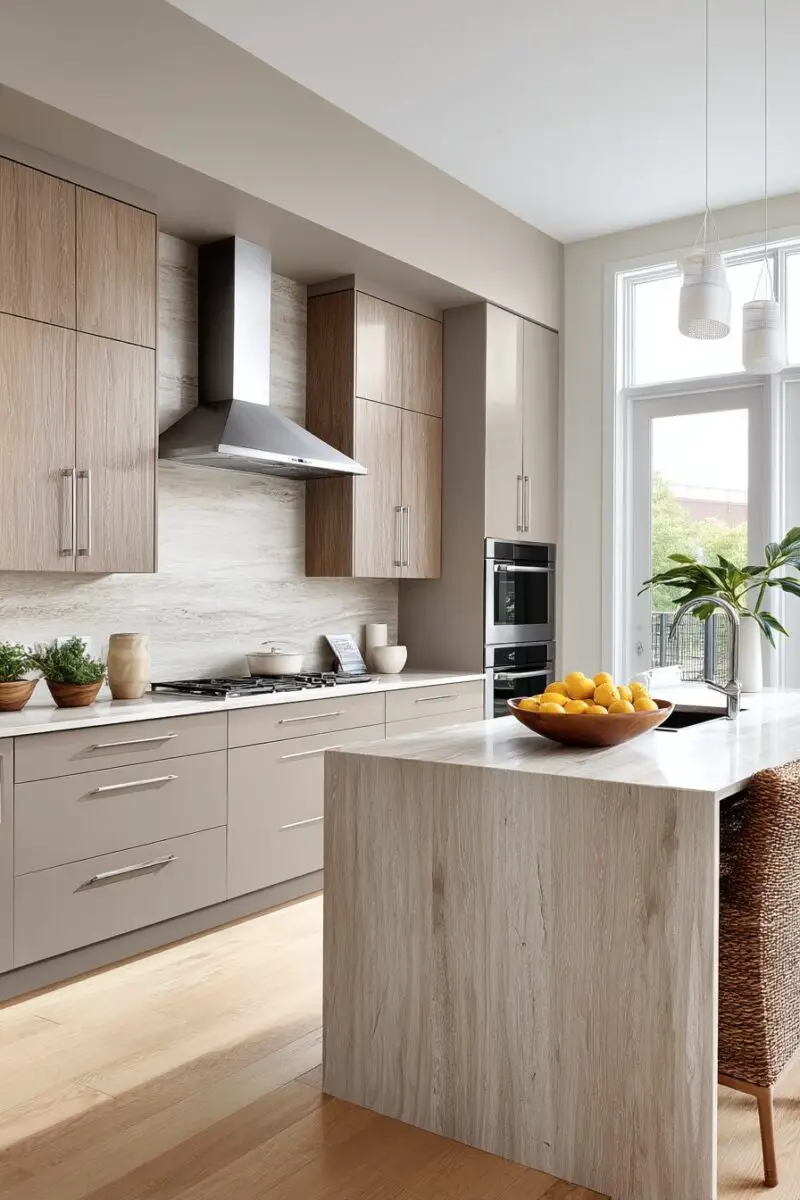
Taupe cabinets possess an unparalleled ability to complement natural materials, creating kitchens that feel both designed and organically evolved.
The earth-derived quality of taupe—neither fully gray nor brown—creates immediate harmony with wood, stone, plants, and other natural elements.
Imagine the stunning contrast of rich walnut open shelving against a backdrop of soft taupe cabinets, each material enhancing the other’s natural beauty.
Alternatively, lighter woods like oak or maple introduce subtle variation while maintaining the kitchen’s overall serene quality.
Natural stone countertops—particularly marble, quartzite, or granite with taupe veining—create seamless transitions that appear almost custom-designed.
For budget-conscious renovations, quartz options mimicking natural stone offer similar aesthetic benefits with added durability alongside taupe cabinets.
Incorporating live plants against taupe backdrops creates vibrant focal points, the greenery popping brilliantly against the neutral foundation.
Rattan or woven pendant lights introduce textural contrast while reinforcing the natural, collected-over-time aesthetic that taupe cabinets support so beautifully.
Exposed wooden beams overhead draw the eye upward while creating visual connection with lower natural elements in a taupe kitchen.
Even small touches—wooden utensils, stone bowls, or woven baskets—take on greater significance against taupe’s subtle backdrop.
Designers particularly value taupe’s chameleon-like ability to adapt to both cool-toned and warm natural materials without conflict.
Reclaimed wood islands or accent sections introduce history and character while the surrounding taupe cabinets provide contemporary balance.
Natural fiber rugs—jute, sisal, or seagrass—anchor taupe kitchens with additional textural elements that enhance the organic quality.
Leather drawer pulls or cabinet handles serve as unexpected natural accents that develop beautiful patina over time against taupe’s stability.
The trend toward biophilic design—incorporating nature into living spaces—finds perfect expression in kitchens featuring taupe cabinets with natural accents.
Unlacquered brass fixtures, which develop natural patina over time, introduce living finishes that evolve alongside your taupe cabinets.
Stone sinks—whether marble, granite, or soapstone—create stunning focal points without overwhelming the subtle sophistication of surrounding taupe cabinetry.
Large windows showcasing garden views essentially function as living art against taupe backgrounds, the interior and exterior engaging in visual conversation.
Butcher block countertop sections introduce warmth and functionality while maintaining the natural aesthetic taupe cabinets so beautifully support.
Professional kitchen designers often recommend taupe specifically for clients seeking timeless spaces that honor natural materials rather than competing with them.
Modern Minimalist Taupe: Clean Sophistication
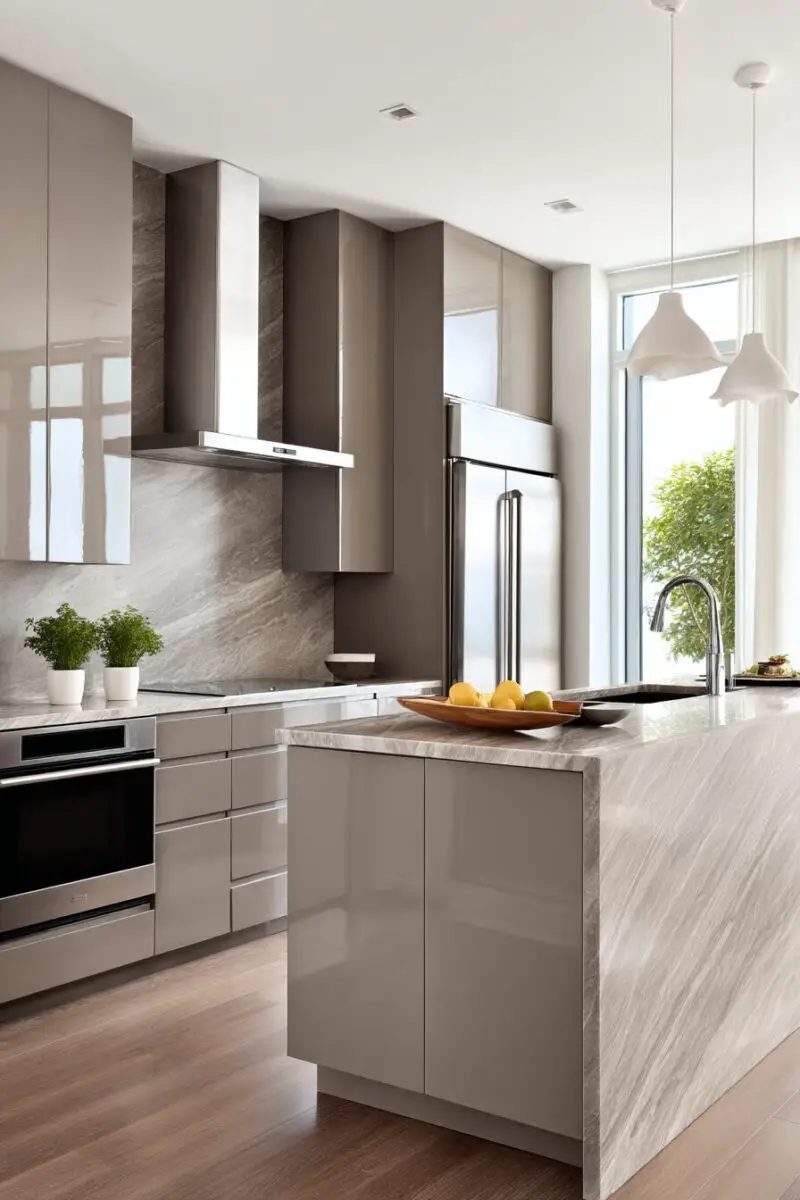
Modern minimalist kitchens featuring taupe cabinets prove that neutral doesn’t mean boring when executed with precision and intention.
The subtle depth of taupe brings necessary warmth to minimalist spaces that might otherwise feel cold or sterile with traditional white or gray.
Flat-panel cabinet fronts in taupe create expansive, uninterrupted surfaces that showcase the color’s nuanced quality without distraction.
Handle-less cabinets with push-open mechanisms or integrated pulls maintain clean lines while letting the taupe finish become the textural element.
This approach works particularly well in open-concept homes, where kitchen cabinetry essentially functions as minimalist furniture within the larger living space.
Waterfall countertop edges—where the surface material continues down the sides—create architectural moments that complement taupe’s contemporary quality.
Strategic use of negative space—perhaps leaving some walls cabinet-free—enhances the minimalist aesthetic while highlighting the taupe elements that remain.
Minimal upper cabinets, replaced instead with single open shelves, create breathing room that prevents taupe from feeling overwhelming in smaller spaces.
Hidden appliances behind matching taupe panels create seamless continuity that supports the clean, uncluttered minimalist vision.
Under-cabinet lighting washes taupe surfaces with gentle illumination, emphasizing their subtle dimension without introducing visual clutter.
European-style compact appliances specifically designed for minimalist kitchens pair beautifully with taupe’s sophisticated restraint.
Monochromatic approaches—where countertops, backsplashes and cabinets all feature subtle variations of taupe—create serene, cohesive environments.
The disciplined minimalist approach allows taupe’s naturally complex character—neither fully cool nor warm—to become a feature rather than simply a background.
Linear lighting fixtures with clean profiles reinforce the contemporary aesthetic without competing with the subtle beauty of taupe cabinets.
Designers note that minimalist taupe kitchens photograph exceptionally well, their subtle sophistication translating beautifully to both digital and print media.
For those concerned about minimalism feeling too austere, taupe introduces just enough warmth to create inviting spaces that still read as disciplined and intentional.
Smart storage solutions hidden behind taupe cabinet fronts—pull-out pantries, specialized organizers, custom inserts—maintain the clutter-free aesthetic.
Minimal hardware in matching taupe or subtle contrasting finishes preserves clean lines while providing necessary functionality.
The careful restraint of minimalist design allows the quality of materials—the depth of a well-executed taupe finish, for example—to become properly appreciated.
Ultimately, modern minimalist taupe kitchens prove that paring back doesn’t mean sacrificing character when color is selected with such careful intention.
TRENDING NOW
13 Clever Storage Ideas To Transform Your KitchenRustic Taupe Cabinets: Countryside Charm
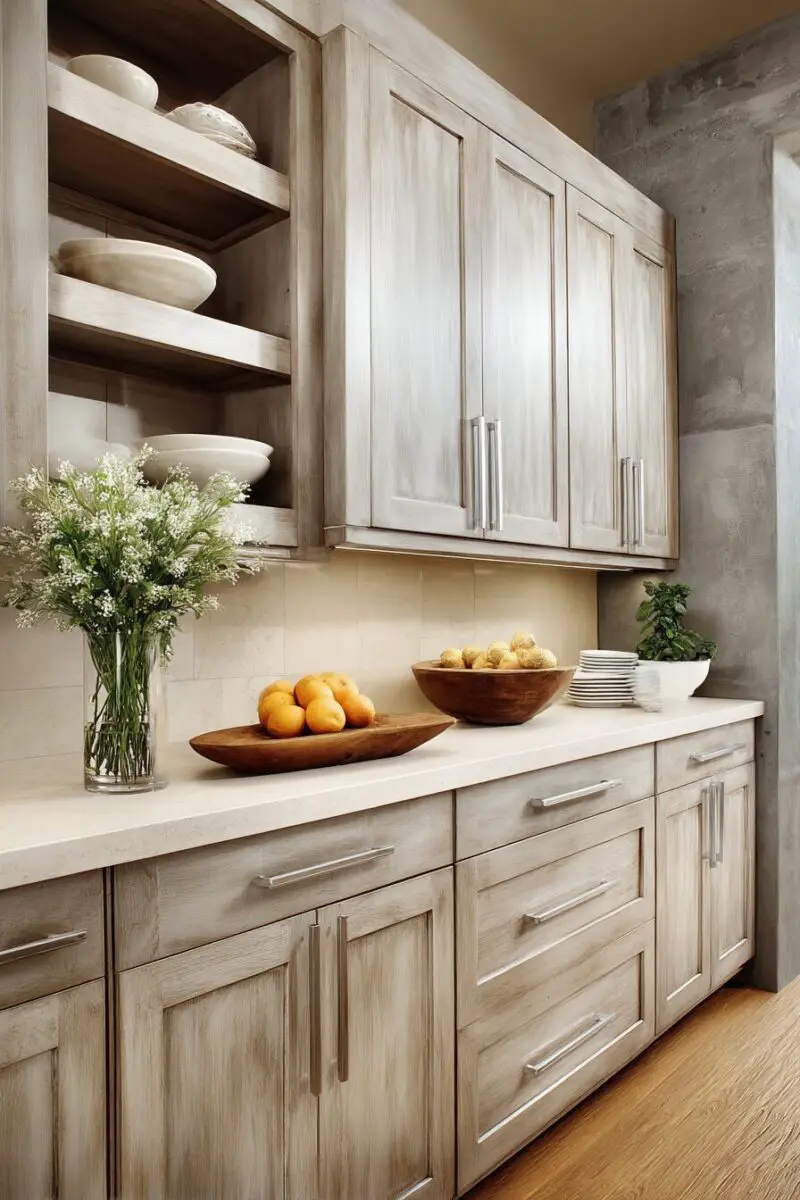
Taupe cabinets in rustic kitchen designs create that coveted lived-in feeling without the heaviness sometimes associated with traditional rustic styles.
The contemporary quality of taupe modernizes rustic elements like shiplap, exposed beams, or farmhouse sinks, preventing the space from feeling themed or dated.
Distressed taupe finishes—where cabinet edges show subtle wear or underlying layers—create immediate character that normally takes years to develop naturally.
These weathered approaches pair brilliantly with authentic rustic elements like reclaimed barn wood islands or antique butcher blocks.
Shaker-style cabinet fronts in taupe strike the perfect balance between rustic simplicity and refined elegance, especially when finished with subtle distressing.
Wrought iron or hammered metal hardware introduces authentic rustic character against the softer taupe backdrop.
Open shelving displaying collected pottery or vintage kitchenware creates that unfussy country feeling while the taupe cabinets provide visual organization.
Stone floors—whether actual stone or porcelain mimicking natural materials—ground rustic taupe kitchens with appropriate earthy elements.
Farmhouse sinks, particularly in fireclay or hammered copper, become natural focal points against surrounding taupe cabinetry.
Exposed ceiling beams stained to complement your taupe shade create cohesive rustic charm without requiring matching exactly.
For authentic countryside character, consider incorporating a taupe kitchen island with turned legs resembling furniture rather than built-in cabinetry.
Vintage rugs featuring subtle taupe tones among more vibrant colors introduce pattern and history while maintaining color cohesion.
Mixing cabinet styles—perhaps glass-fronted upper cabinets with solid taupe base cabinets—creates that collected-over-time feeling essential to authentic rustic spaces.
Rustic lighting—whether wrought iron pendants or repurposed vintage fixtures—casts warm illumination that enhances taupe’s dimensional quality.
Apron-front cabinet detailing, beadboard accents, or V-groove panels introduce architectural interest while maintaining the rustic aesthetic.
Designers particularly value how taupe unifies disparate rustic elements that might otherwise create visual chaos if paired with stronger cabinet colors.
Natural stone backsplashes with irregular edges or tumbled finishes introduce appropriate rustic texture while complementing taupe’s subdued elegance.
Floating wooden shelves—perhaps with live edges or visible knots—create stunning contrast against more refined taupe cabinet sections.
Vintage hardware with patina—perhaps glass knobs with brass backplates or cup pulls with visible wear—personalize taupe cabinets with historical character.
The beauty of rustic taupe kitchens lies in their ability to feel simultaneously timeless and current, nodding to tradition while remaining thoroughly livable for modern families.
TRENDING NOW
13 Smart Kitchen Organization Ideas You NeedTaupe and Texture: Dimensional Depth
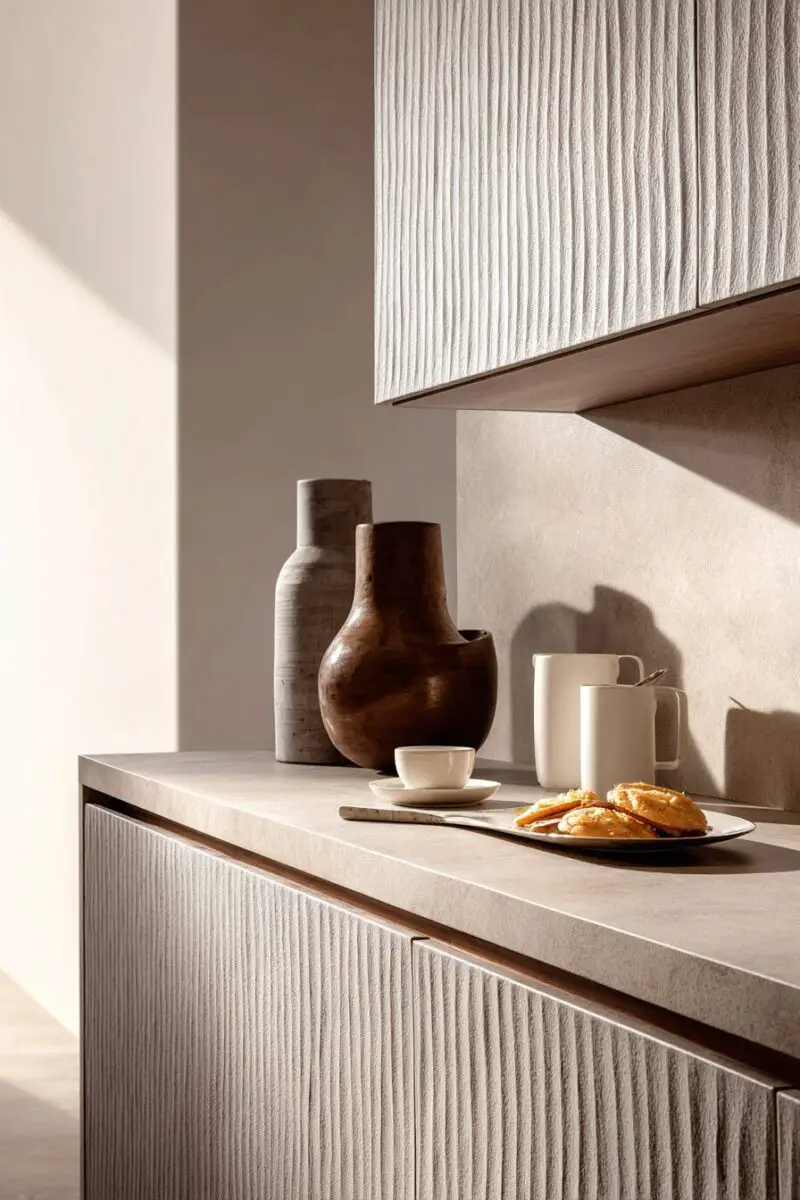
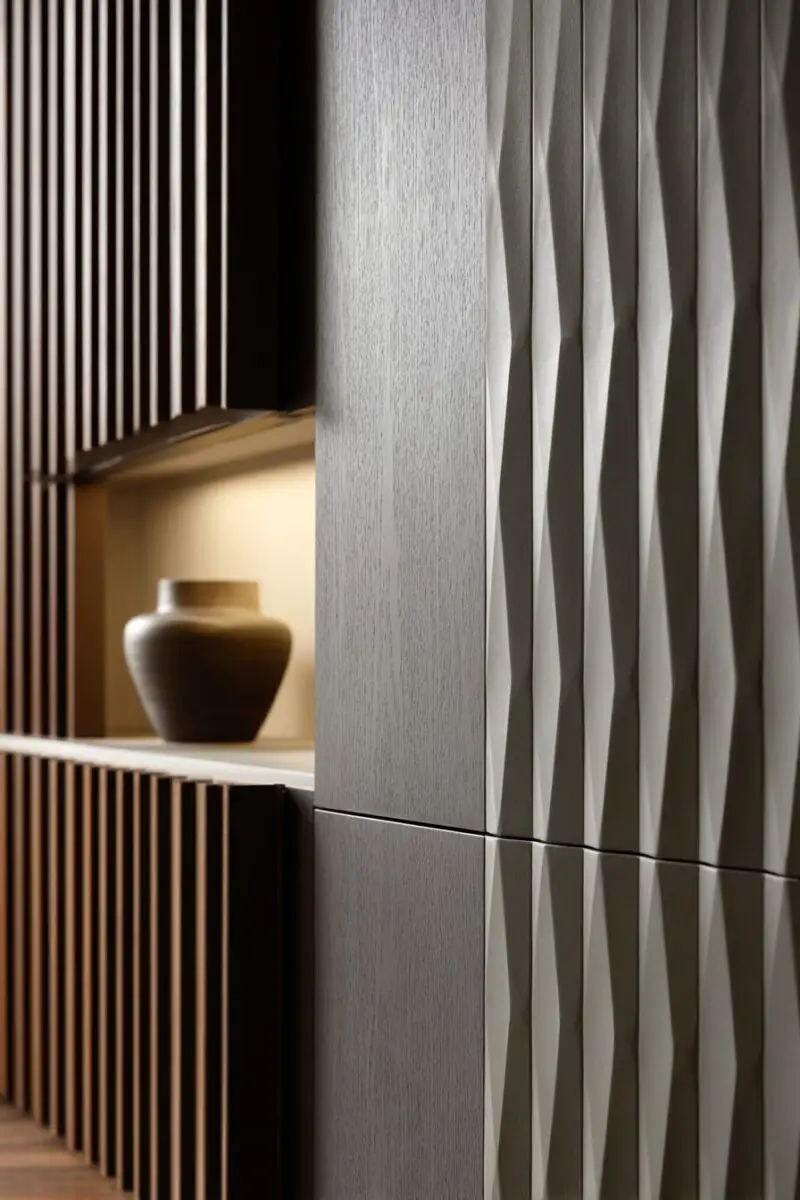
Texture transforms taupe from simply a color choice to a multi-dimensional design element that engages both visually and tactilely.
While flat taupe surfaces certainly have their place, textured cabinet fronts—whether subtle wood grain, beadboard, or more pronounced patterns—create dynamic interest.
Light plays differently across textured taupe surfaces, creating natural highlights and shadows that showcase the color’s complex undertones.
Simple Shaker frames introduce just enough dimensional variation to create interest while maintaining taupe’s inherent sophistication.
For more dramatic effect, consider heavily textured cabinet fronts with pronounced wood grain or wire-brushed finishes that emphasize tactile quality.
Designers increasingly pair smooth taupe cabinet sections with textured elements, perhaps featuring textured drawer fronts amid flat cabinet doors.
Reeded or fluted cabinet details—vertical grooves running along doors or islands—introduce architectural texture that feels both classic and contemporary.
Grass cloth or textured wallpaper in complementary taupe shades creates stunning accent walls that amplify the dimensional quality of your cabinetry.
Beyond the cabinets themselves, textured backsplashes—handmade zellige tiles, three-dimensional ceramics, or stacked stone—create dialogue with taupe’s subtle depth.
Contrast becomes key when working with texture and taupe—smooth countertops, for instance, provide relief from textured cabinets, preventing visual overwhelm.
Natural materials inherently bring textural variation—consider honed granite or leathered countertops that introduce additional tactile elements.
The inherent restraint of taupe allows for more adventurous textural choices that might appear excessive with more assertive cabinet colors.
Ribbed glass cabinet inserts paired with taupe frames introduce transparent texture that adds depth without adding visual weight.
Woven pendant lights cast fascinating shadow patterns across textured taupe surfaces, creating ever-changing visual interest throughout the day.
Textured cabinet hardware—hammered metals, carved wood, or even leather-wrapped pulls—introduces additional tactile pleasure to daily kitchen interactions.
Professional designers recognize that textured taupe kitchens photograph particularly well, the dimensional quality translating even to two-dimensional images.
Mixing textural elements within the same taupe palette—perhaps combining matte and slight-sheen finishes—creates subtle sophistication that rewards close attention.
For those concerned about trends, textured taupe represents a particularly sound investment, as texture adds timeless interest to a similarly timeless color choice.
Open shelving displaying textural elements—woven baskets, pottery with varied glazes, or wood cutting boards—extends the textural conversation beyond cabinetry.
The ultimate luxury in contemporary kitchen design might well be textured taupe cabinetry that invites both visual appreciation and physical interaction.
Taupe with Pops of Color: Balanced Brilliance

Taupe cabinets create the perfect neutral foundation for introducing vibrant color accents that energize without overwhelming your kitchen.
The beauty of this approach lies in its flexibility—your colorful elements can be easily updated as trends or preferences change while the taupe remains timelessly appropriate.
Bold pendant lights in cobalt blue, emerald green, or sunny yellow create immediate focal points against taupe’s restrained backdrop.
Colorful appliances—perhaps a candy-colored stand mixer or a retro-style refrigerator—become functional art pieces against neutral cabinetry.
For less permanent color introductions, consider vibrant dishware displayed on open shelving or glass-front cabinets set within taupe surrounds.
Upholstered counter stools featuring patterned fabrics with coordinate or contrast with your chosen accent colors create comfortable color moments.
Window treatments offer another opportunity for introducing pattern and color while maintaining the sophisticated foundation taupe cabinets provide.
The rule of three—repeating your chosen accent color in at least three places—creates intentional cohesion rather than random splashes of brightness.
Runners or area rugs incorporating both taupe and your accent colors create natural bridges between neutral and vibrant elements.
For truly dramatic impact, consider a colored island base—perhaps navy blue or forest green—while keeping perimeter cabinets in versatile taupe.
Backsplashes offer perfect opportunities for colorful expression, whether through vibrant tile, painted glass, or even wallpaper behind clear acrylic panels.
Designers particularly value how taupe cabinets allow for seasonal color adjustments through easily changed accessories, flowers, and textiles.
For color-lovers concerned about commitment, taupe cabinets with colorful interior cabinet boxes provide delightful surprises each time doors open.
Even small touches—colored cabinet knobs, bright dish towels, or vibrant fruit displayed in bowls—make significant impact against taupe’s neutrality.
The psychological impact of thoughtfully placed color creates energy and personality while the surrounding taupe provides necessary visual rest.
The contrast between vibrant accents and neutral taupe naturally draws the eye to your chosen focal points, creating movement through the space.
Professional color consultants recommend selecting accent hues that complement taupe’s specific undertones—whether they lean more gray, brown, or even slightly purple.
Live plants with colorful pots introduce both natural elements and customized color that can easily evolve with changing preferences.
For particularly bold color introductions, consider painting your ceiling an unexpected hue while keeping walls neutral to complement your taupe cabinets.
The genius of taupe with color pops lies in creating kitchens that feel simultaneously timeless and personal, balancing design longevity with individualized expression.
Taupe Open Shelving Combo: Curated Display


The strategic combination of closed taupe cabinets with open shelving creates kitchens that balance practicality with personalized display opportunities.
This approach satisfies both organizational needs—hiding necessary but less attractive items behind taupe doors—and the desire to showcase beautiful pieces on open shelves.
Taupe’s neutral quality ensures that items displayed on adjacent open shelving become the stars rather than competing with cabinet color.
The dimensional contrast between solid cabinet masses and airy open sections creates visual rhythm that prevents the kitchen from feeling heavy or closed-in.
Floating wooden shelves—perhaps in natural oak, walnut, or even reclaimed timber—create stunning material contrast against taupe cabinet sections.
Alternatively, shelves painted the exact same taupe as surrounding cabinets create seamless visual continuity while still providing display opportunities.
Strategic lighting—whether recessed puck lights or subtle LED strips—transforms open shelving into gallery-like display areas for your most treasured pieces.
Designers recommend limiting open shelving to approximately 20-30% of your storage to maintain adequate closed storage while creating display impact.
The items you choose to display—whether collected pottery, cookbook libraries, or everyday glassware—become curated expressions of your personal style.
Practical considerations include placing open shelving away from cooking areas where grease might accumulate on displayed items.
Upper cabinet sections converted to open shelving immediately create airier kitchens while base cabinets in taupe provide necessary hidden storage.
For those concerned about dust, strategic placement of frequently-used items on open shelves ensures regular rotation that minimizes cleaning concerns.
Color-coordinated collections—perhaps white ceramics or glassware in specific hues—create cohesive displays that complement rather than compete with taupe cabinetry.
The negative space created by open shelving allows taupe cabinets to “breathe,” preventing the color from feeling overwhelming in smaller kitchens.
Structural considerations include ensuring proper anchoring for open shelving, particularly when displaying heavier items like cookbook collections or appliances.
Interior designers particularly value this combination for its flexibility—open shelving can be seasonally restyled while taupe cabinets provide consistent background.
For rental properties or temporary situations, removable open shelving paired with taupe cabinets creates personalized spaces without permanent modifications.
The open/closed combination works equally well in various kitchen layouts, from galley configurations to large open-concept spaces.
Professional organizers recommend displaying items on open shelving that enhance both function and beauty—think matching glass storage containers or artisanal cooking tools.
Ultimately, taupe cabinets with open shelving sections create kitchens that feel simultaneously well-organized and personally expressive, balancing pragmatism with personality.
Taupe Cabinets for Small Kitchens: Space-Maximizing Magic
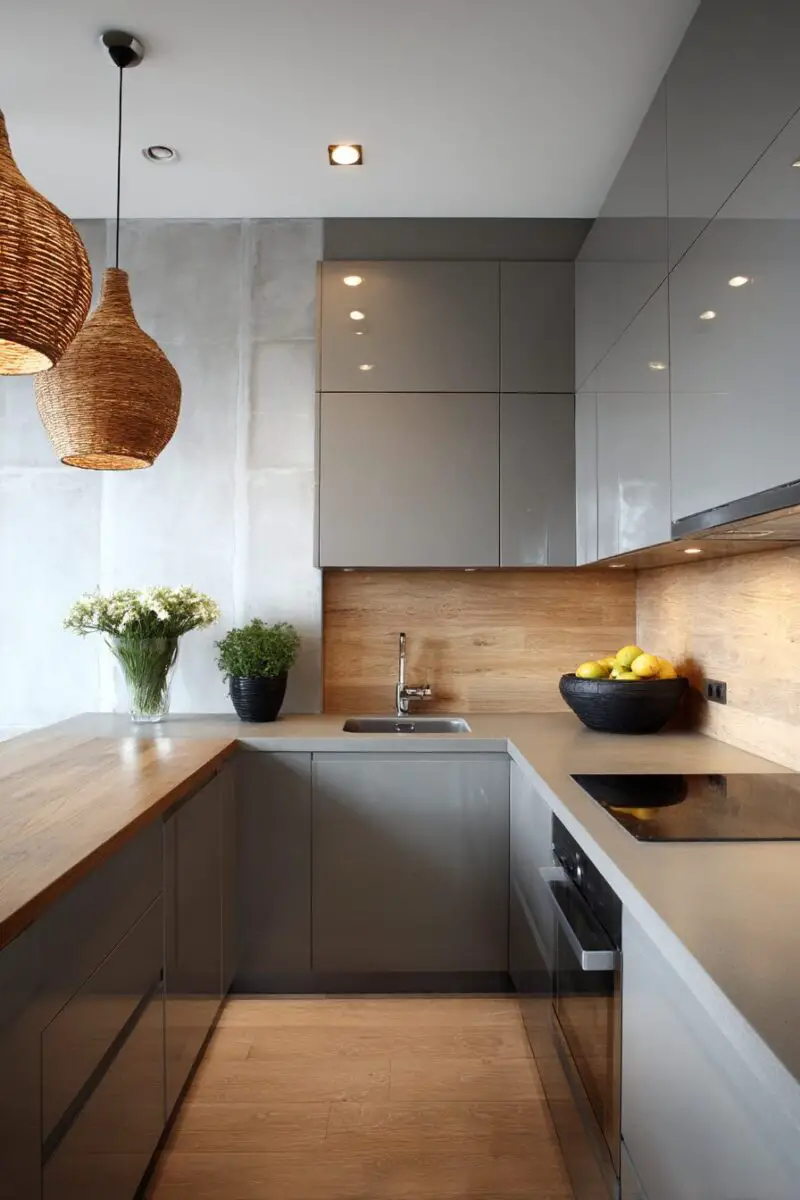
Taupe cabinets perform remarkable spatial magic in smaller kitchens, creating depth without the closing-in effect darker colors can produce.
Unlike pure white (which can feel clinical) or dark colors (which can feel confining), taupe hits the perfect middle note for visually expanding tight quarters.
Continuous taupe cabinetry from floor to ceiling eliminates visual breaks that can make small spaces feel choppy or disjointed.
Selecting hardware that blends with your taupe shade—rather than contrasting sharply—creates sleek, uninterrupted visual flow that expands perceived space.
Cabinet doors extending fully to the ceiling eliminate dust-collecting dead space while maximizing storage in compact kitchens.
Taupe’s ability to disguise minor scuffs and stains makes it particularly practical for small kitchens where daily wear is concentrated in limited areas.
Handle-less taupe cabinets with push-latch mechanisms eliminate protruding hardware that can disrupt movement in narrow kitchen pathways.
Strategic mirror placement—perhaps as a backsplash section or on a pantry door—reflects light across taupe surfaces, immediately doubling perceived space.
Continuous flooring that runs uninterrupted beneath taupe cabinetry creates visual expansion, particularly effective with consistent color palettes.
For galley kitchens, taupe cabinets on both sides create balanced corridors that feel intentional rather than cramped.
Under-cabinet lighting washes taupe surfaces with illumination that pushes back walls and eliminates shadows that might make spaces feel smaller.
Glass-front cabinet sections or open shelving interspersed with solid taupe cabinets create depth perception that expands spatial awareness.
Corner solutions—whether lazy susans or clever pull-out systems behind taupe doors—maximize awkward spaces that often go underutilized in small kitchens.
Slim pull-out pantries, spice racks, or cutting board storage hidden behind taupe panels transform narrow gaps into functional storage.
Reflective surfaces—quartz countertops with subtle sheen or glossy tile backsplashes—bounce light around taupe cabinetry to enhance spaciousness.
Consistent color flow—where walls, trim and cabinetry feature closely related taupe shades—eliminates visual boundaries that can make spaces feel confined.
Professional kitchen designers often recommend taupe specifically for small-space clients because it creates depth without heaviness.
Vertical storage solutions behind taupe doors—tray dividers, pull-out pantries, or specialized organizers—maximize cubic footage in limited floor plans.
Properly scaled appliances—perhaps 24-inch rather than standard 30-inch—maintain proportion with taupe cabinetry in smaller kitchens.
The subtle sophistication of taupe elevates small kitchens from merely functional to genuinely special, proving that limited square footage doesn’t require sacrificing style.
Taupe kitchen cabinets represent that rare design choice combining timeless appeal with contemporary relevance, creating spaces that feel simultaneously fresh and enduring.
Whether you’re planning a complete kitchen renovation or simply refreshing existing cabinets, taupe’s versatility adapts to your unique style, space constraints, and design vision.
The beauty of choosing taupe lies not just in its sophisticated neutrality, but in the freedom it provides to express your personality through complementary elements.
As you consider your own kitchen transformation, remember that the most successful spaces reflect not just current trends but your authentic lifestyle and preferences.
